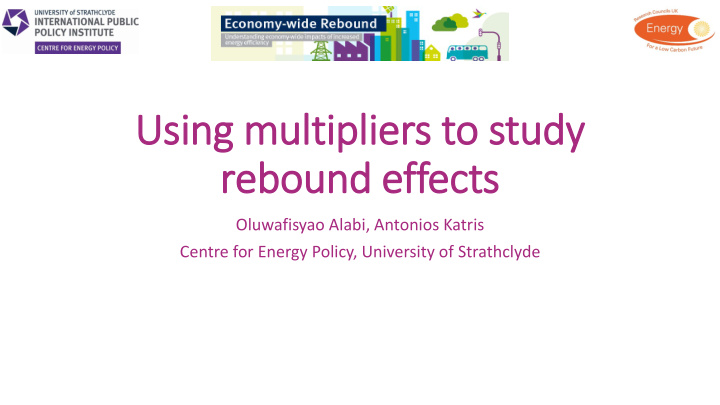



Using multipliers to study rebound effects Oluwafisyao Alabi, Antonios Katris Centre for Energy Policy, University of Strathclyde
Structure of f presentation • Part A – Antonios Katris • Multipliers featured in our work • What is a rebound effect? • Can we study rebound using multipliers? • Part B – Oluwafisayo Alabi • Scottish multipliers • What are our limitations? • How can multipliers be used for Scottish case studies?
Part A
Multipliers featured in our work • Multiplier analysis a widely used tool in IO frameworks • For example Employment multiplier shows the changes in employment throughout the economy following a change in employment in one sector • We focus on embodied energy use/emissions • Output multipliers key for our work • Our output multipliers show the change in energy use and CO 2 emissions due to a change in final demand
• Simple scenario; Improved energy efficiency in UK households reduces spending to EGWS sector by 10%
• If savings are re-spent to Global Food and Beverage Manufacture we have an increase in energy use/carbon emissions • Main impact overseas
• Does this increase offset the original savings due to improved energy efficiency? • We need to examine the net change in energy use/ emissions • The benefits from improved energy efficiency have been reduced • Still net energy/CO 2 savings
What is a rebound effect? • The energy (carbon) savings are not limited to the reduced energy use (carbon emissions) of the households • Further savings on the EGWS supply chain; Rebound effect • We focus on indirect rebound effect • Rebound indicator 𝐵𝐹𝑇 • 𝑆 = 1 − 𝑄𝐹𝑇 × 100 • Ratio of Actual Energy Savings (AES) achieved over Potential Energy Savings (PES) anticipated • We want negative R • Actual savings larger than Potential • If AES positive then we have net energy (carbon) savings • No standard definition for PES
Can we use multipliers to study rebound? • We propose the use of a Carbon Saving Multiplier (CSM) instead of R • CSM is calculated using the following formula 𝐷ℎ𝑏𝑜𝑓 𝑗𝑜 𝑓𝑛𝑐𝑝𝑒𝑗𝑓𝑒 𝑓𝑛𝑗𝑡𝑡𝑗𝑝𝑜𝑡 • 𝐷𝑇𝑁 = 𝐸𝑗𝑠𝑓𝑑𝑢 ℎ𝑝𝑣𝑡𝑓ℎ𝑝𝑚𝑒 𝑓𝑛𝑗𝑡𝑡𝑗𝑝𝑜𝑡 𝑡𝑏𝑤𝑗𝑜𝑡 • CSM tells the same story as R • In example CSM=2.89 • For every kt of CO 2 saved by UK households further 1.89 kt are saved globally
• Thank you for your attention • Further information can be found on the policy briefing • Oluwafisayo will continue with the second part of the presentation
Part B
Introduction Inter-country and Global case Scottish Case o What are the Carbon Savings Multipliers for Scotland? o What are the GHG multiplier impacts in Scotland for different ‘Eat’, ‘light’, ‘Heat’ and ‘Travel’ domestic spending options? o Data: Scottish Input-Output (IO) Tables (2012) and UK Average Sectoral GHG Intensities.
GHG Multiplier impacts in Scotland (CO2(e) per £1m) for different 'eat', ‘light’, ‘heat' and 'travel' domestic spending options 4.00 More GHG Intensive 3.50 3.34 GHG Multiplier Impact in Scotland (CO2(e) per £1m) 3.00 Scottish Input-Output Less GHG Intensive Tables 2012 & UK 2.56 2.50 Average Sectoral GHG Intensities Direct Emissions 2.00 from household not accounted for 1.50 1.37 1.02 0.96 1.00 0.67 Eat 0.58 0.43 Light 0.50 0.36 0.27 Heat Travel 0.00 Meat Fish/fruit Dairy Bakery Electricity Gas etc. Rail transport Other land Water transport Air transport transport
Working towards Carbon Saving Multipliers (CSM) for Scotland Scotland is in an excellent position with regard to economic input-output accounting data , however a key challenge/problem is a Data lack of region-specific data on sectoral GHG Further Applications: How GHG is distributed within Scotland’s supply chain. Use Scottish Data to replace the electricity GHG intensities to see how the multipliers change. Replicate similar scenarios as in the inter-country case.
Conclusions Advantages of Input-Output Multiplier Analysis Useful tool for examining the interdependences within an economy and the interactions between the economy and the environment. Flexibility framework or tool (e.g. Inter-country or Regional and can be used to consider other pollutants, waste and resource uses) Alternatives tool/method to Rebound measures. Support existing economic and environmental policies or inform new policy decisions. (Key questions and ‘What if’ scenarios) Still on the Scottish case……….. Gioele will give a fuller economy wide perspective on ‘can rebound effects reduce fuel poverty’ linked to WP4.
Recommend
More recommend